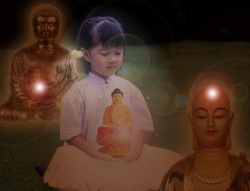Difference between revisions of "Phassa"
m (Text replacement - "]]]" to "]])") |
|||
| Line 4: | Line 4: | ||
For any [[sense-impression]] to occur, three things are [[essential]] - namely, [[consciousness]], respective [[sense]] and the [[object]]. For instance, one sees an [[object]] with the [[consciousness]] through the [[eye]] as its instrument. | For any [[sense-impression]] to occur, three things are [[essential]] - namely, [[consciousness]], respective [[sense]] and the [[object]]. For instance, one sees an [[object]] with the [[consciousness]] through the [[eye]] as its instrument. | ||
| − | When an [[object]] presents itself to the [[consciousness]] through one of the [[six senses]] there arises the [[mental]] state-contact. "[[It should not be understood that mere collision is contact]] | + | When an [[object]] presents itself to the [[consciousness]] through one of the [[six senses]] there arises the [[mental]] state-contact. "[[It should not be understood that mere collision is contact]])] ([[Na sangatimatto eva Phasso]]). |
Like a pillar which acts as a strong support to the rest of the structure, even so is [[contact]] to the coexistent [[mental]] [[concomitants]]. | Like a pillar which acts as a strong support to the rest of the structure, even so is [[contact]] to the coexistent [[mental]] [[concomitants]]. | ||
Latest revision as of 01:22, 5 April 2016
2. Phassa- Derived from Ö phas, to contact.
For any sense-impression to occur, three things are essential - namely, consciousness, respective sense and the object. For instance, one sees an object with the consciousness through the eye as its instrument.
When an object presents itself to the consciousness through one of the six senses there arises the mental state-contact. "It should not be understood that mere collision is contact)] (Na sangatimatto eva Phasso).
Like a pillar which acts as a strong support to the rest of the structure, even so is contact to the coexistent mental concomitants.
"Contact means 'it touches' (phusatī'ti). It has touching (phusana) as its salient characteristic (lakkhana), impact (sanghattana) as its function (rasa), coinciding (of the physical basis, object and consciousness) as its manifestation (sannipāta paccupatthāna), and the object which has entered the avenue (of awareness) as proximate cause (padatthāna)."
Contact is mentioned first because it precedes all other mental states. "Touching by contact, consciousness experiences by feeling, perceives by perception, wills by volition - (Phassena phusitvā, vedanāya vediyati, saññāya sañjānāti, cetanāya ceteti)". According to Paticca-Samuppāda, too, Contact conditions Feeling. But strictly speaking, there is no reason for the sequence because all these mental states are coexistent. The Atthasālini states - "For of states, arisen in one conscious moment, it is not valid to say that 'this' arises first, 'that' afterwards. The reason is not because contact is a strong support. Contact is just mentioned first in the order of teaching, but it was also permissible to bring it in thus: - There are feeling and contact, perception and contact, volition and contact; there are consciousness and contact, feeling, perception, volition, initial application of mind. In the order of teaching, however, contact is mentioned first. Nor is the sequence of words among the remaining states of any special significance."
"Contact is given priority of place, as standing for the inception of the thought, and as the sine qua non of all the allied states, conditioning them much as the roof-tree of a storeyed house supports all the other combinations of material."
(Mrs. Rhys Davids - Buddhist Psychology, p. 6.)
see also: Sparśa
